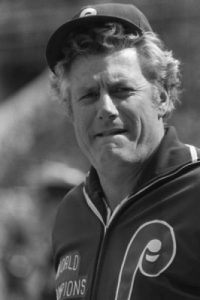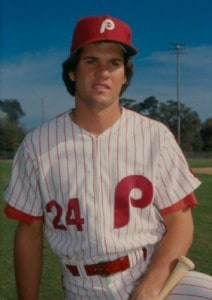Sandberg was a 22-year-old prospect in January 1982
This latest installment of the “Phillies Hot Stove History” series was inspired by today’s 66th birthday celebration for Ivan DeJesus. While we may celebrate his birthday, few Phillies fans have ever celebrated the 1982 swap of shortstops that brought him to the team.
This latest installment of the “Phillies Hot Stove History” series was inspired by today’s 66th birthday celebration for Ivan DeJesus. While we may celebrate his birthday, few Phillies fans have ever celebrated the 1982 swap of shortstops that brought him to the team.
In short order this would prove to be one of the worst trades in franchise history. For younger fans who may have heard of the deal but not know how such a thing could happen, let’s take a quick look back at this key “hot stove” moment from the Phillies past.
As always, a little perspective is required to set the stage. At the time of the deal the Phillies were coming off a 1981 season in which they had been dethroned as world champions.
The veteran-laden 1980 Phillies had won the first World Series crown in franchise history. The following season was interrupted by a mid-season work stoppage, and the Phillies would return to the playoffs in 1981 thanks in part to a split-season format adopted by Major League Baseball.
In baseball’s first-ever Divisional Series, the Phillies were eliminated by the Montreal Expos in five games. Following that 3-2 series defeat, Owens looked over his roster and felt that an aging team that had won four of five NL East titles between 1976-80 needed more adjustments.
One key member of that 1970’s core group and 1980 championship team had already been dealt away when left fielder Greg Luzinski was sold to the Chicago White Sox at the end of spring training just prior to the 1981 season.
Owens decided that it was now time to turn the pages on the 36-year-old shortstop Larry Bowa, with whom he was having difficulty reaching agreement on a new contract.
THE GREEN FACTOR
Another pivotal factor in the trade was the man sitting in the General Manager’s seat on the Cubs side of the deal. Dallas Green had skippered the Phillies to that 1980 World Series title. Following the 1981 playoff defeat, Green was hired to become the new GM in Chicago.
| Green skippered Phillies to a World Series crown and 1981 postseason, then became Cubs GM. |
Just over a month later, Green and Owens were discussing another trade. There wasn’t much at the time to distinguish Bowa from Cubs shortstop Ivan DeJesus from one another as a player. Both were light hitters. Bowa had the far greater defensive pedigree. DeJesus was more than seven years younger.
The big factor for Green was that he wanted Bowa’s strong glove, fiery personality, and leadership as the GM instituted his “Building a New Tradition” plan for a franchise that hadn’t been to the postseason since 1945.
On the Phillies side, Owens was looking for a long-term replacement, one where the talent level wouldn’t drop off much, to help keep the club winning. It appeared to be a clean, simple swap at the shortstop position.
However, because of that age difference between Bowa and DeJesus in the Phillies favor, Green insisted that Owens toss in a young infield prospect. With his intimate knowledge of the Phillies farm system, Green had always liked Ryne Sandberg, and insisted on him as the throw-in player as a possible future shortstop. Owens agreed, and the deal was done.
THE THROW-IN
Most in the Phillies scouting department regarded Sandberg, the club’s 20th round selection in the 1978 MLB Amateur Draft out of a Spokane, Washington high school, as a borderline prospect. He could play second base and shortstop, possibly even some third base.
| Sandberg was a 20th round draft pick who most felt would become a reserve infielder. |
As the Phillies took part in that 1981 split-season, Sandberg was enjoying a solid season with Triple-A Oklahoma City. He hit .293 while swiping another 32 bags, earning a September promotion to the big-leagues.
With the Phillies during that month of September in 1981, Sandberg got into 13 games. Seven of those were as a pinch-runner. He also played in five as a shortstop, and another at second base.
Three of Sandberg’s appearances during that cup-of-coffee, including the final two on October 2nd and 3rd, came against the Cubs at Veteran’s Stadium. He also had played short during a game at Wrigley Field in the second game of a September 27 doubleheader.
THE SHORTSTOPS
On January 27, 1982 the deal was concluded. Bowa and Sandberg were shipped out to the North Side of the Windy City, while DeJesus became the new shortstop in red pinstripes. The rest is, unfortunately for the Phillies, baseball history.
| Bowa was a 36-year-old, 12-year veteran at time of the deal. |
DeJesus would play three seasons with the Phillies and help the club to win the 1983 National League pennant. That team would lose the World Series in five games to the Baltimore Orioles. Over those three years, DeJesus slashed just .249/.319/.319 with 153 runs scored and 37 total steals.
Bowa spent most of the next three seasons as the Cubs starting shortstop, slashing .247/.296/.308 with 169 runs scored and 30 stolen bases while helping the team to the 1984 NL East crown. Chicago would release him at age 39 in August of 1985, and he would finish out his career playing for a month with the New York Mets.
Seems like a wash at that point. But of course, that was not the whole story. There was the issue of that prospect tossed into the deal. Sandberg quickly proved to be far more than a throw-in.
THE HALL OF FAMER
During his rookie season of 1982, Sandberg became the Cubs starting third baseman. He hit .271 with 33 doubles, 103 runs scored, and 32 stolen bases, finishing sixth in the National League Rookie of the Year voting.
If the Phillies weren’t already realizing that they had made a grave mistake including him in the trade, Sandberg’s 1983 performance would drive home that point.
In that 1983 campaign, Sandberg scored 94 runs, stole 37 bases, and was honored with the NL Gold Glove at second base. If you thought that his development into a star was tilting the deal way over into the Cubs side at that point, you hadn’t seen anything yet.
The following season he would up his game once again as Sandberg became an NL all-star for the first time. In 1984 he slashed .314/.367/.520 with 19 home runs among 74 extra-base hits, leading all of baseball with 19 triples. He also produced 84 RBI, stole 32 bases, and led the NL with 114 runs scored.
For that performance, Sandberg captured the National League Most Valuable Player award. He also was honored with his second consecutive NL Gold Glove and was awarded the NL Silver Slugger at second base.
| Sandberg became an NL MVP and perennial NL All-Star, Gold Glover, and Silver Slugger (Photo: Wjmummert) |
Sandberg won nine consecutive Gold Glove Awards from 1983-91, as well as seven Silver Sluggers during that same period. He was an NL All-Star for 10 straight years from 1984-93.
Sandberg finished his career with a .989 fielding percentage, the highest for a second baseman in baseball history.
He produced 15 streaks of 30 or more consecutive errorless games, and at the time of his retirement after the 1997 season, he held the all-time record of 123 consecutive errorless games by a second baseman.
During his third year of eligibility in 2005, Sandberg was elected into the Baseball Hall of Fame, receiving 76.2% of the vote that year.
He produced 15 streaks of 30 or more consecutive errorless games, and at the time of his retirement after the 1997 season, he held the all-time record of 123 consecutive errorless games by a second baseman.
During his third year of eligibility in 2005, Sandberg was elected into the Baseball Hall of Fame, receiving 76.2% of the vote that year.
As a post-script to this story, Sandberg entered the coaching and managerial ranks following his retirement as a player. Starting as a spring training instructor with the Cubs, he was hired to manage within their minor league system with the goal of becoming the Cubs manager one day.
When that opportunity didn’t come about, Sandberg left to become manager of the Phillies Triple-A affiliates at Lehigh Valley where he became the 2011 Minor League Manager of the Year.
In 2013, Sandberg was back in the big-leagues as the Phillies third base coach. Then in mid-August he was named Manager of the Phillies following the firing of long-time skipper Charlie Manuel. Sandberg would compile a 119-159 record over parts of three seasons before rising the position in early June of 2015.
There have been many trades made during baseball’s “hot stove” months, that late-fall through mid-winter period when teams are positioning their team for the following season, where prospects have been included as supposed “throw-in” players.
Every once in a while a team will hit the jackpot with one of those young players. That was never more the case than with the Phillies-Cubs hot stove trade of Bowa and Sandberg for DeJesus in January 1982.
Originally published at Phillies Nation as "Phillies Hot Stove History: The 1982 trade of Ryne Sandberg"
Originally published at Phillies Nation as "Phillies Hot Stove History: The 1982 trade of Ryne Sandberg"






No comments:
Post a Comment